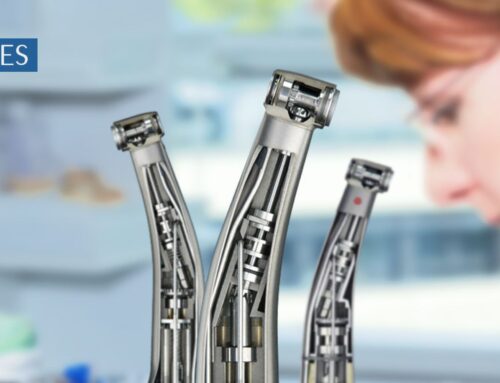Any dentist will tell you that a key to successful dentistry is having high-quality dental handpiece equipment. But what are dental handpieces, anyway? And why are they so important? In this article, we’ll look at the basic features of dental handpieces, how they work and how you can choose one that best fits your needs.
What is a Dental Handpiece?
Dental handpieces are medical devices that are used to perform a wide variety of dental procedures, including the removal of decay, polishing fillings, performing cosmetic dentistry, altering prosthetics, etc. These Dental handpieces are very important in a dentist’s daily routine.
From drilling and cutting teeth, placing implants, and removing decaying material, these tools make it possible for dentists to do their job with minimal effort and increase their precision. In other words, we can say, a dental handpiece is a device used by dentists and dental hygienists for performing many different dental procedures. It is normally attached to an air compressor and uses water spray, air, and electricity.
These devices help in providing better accessibility and visibility, as well as precise control over tiny areas of hard or soft tissues of the mouth.
History of Dental Handpiece
According to Wikipedia 7000 BC is the earliest evidence of dentistry being practiced in the Indus Valley Civilization. The earliest form of dentistry involved treating teeth-related disorders using bow drills operated, perhaps, by skilled bead craftsmen. This ancient form of dentistry was reconstructed and proved to be effective and reliable.
Cavitation of 3.5 mm depth and concentric grooves indicate the use of a drill. Cavities of 3.5 mm depth and concentric grooves indicate drilling.
A British dentist named George Fellows Harrington invented a clockwork dental drill named Erado in 1864. It was faster than earlier drills, but it was also very noisy.
An American dentist named George F. Green developed the pedal-operated pneumatic dental 1875 was the year Green patented the first electric dental drill, a development that reshaped dentistry.
By 1914, electric dental drills were capable of rotating at speeds up to 3000 rpm. In the 1950s and 1960s, the air turbine drill was developed as part of the second wave of rapid development.
First Electrical Dental Handpiece Invention
George Fellows Harrington, a British dentist, designed a more sophisticated handpiece in 1864. This device used a clockwork mechanism and was extremely loud.
He named it Erado. Dr. George F. Greene, an American dentist, invented a pedal drill four years later, in 1868.
The first burr drill was invented by James B. Morrison in 1871, and the first electric drill was invented by Dr. Green in 1875, revolutionizing dentistry. Electric handpieces were in common use by 1914, reaching speeds of up to 3,000 rpm.
Modern Day/ Present Day Dental Handpiece
In modern dentistry, dental handpieces have taken over virtually all of the work formerly done by chisels and gouges. Dentists still use these tools during root canal therapy, but other than that, dental handpieces are used for every dental procedure.
There are different kinds of dental handpieces for accomplishing a variety of tasks: Endodontic (root canal) instruments cut and clean out canals; Prophylaxis or curettes remove plaque from around teeth; Burs remove stains from teeth; Rotary instruments remove decay.
Dental handpieces use electricity or ultrasonic to create power which makes them more precise than manual instruments. High-speed versions may be used to drill down into tooth enamel during tooth preparation procedures.
Types Of dental Handpiece
Some people may think that all dental handpieces are similar but that is not true. There are several types of dental handpieces available in markets.
Also, some type of dental handpiece gives better results than others and so it is important for you to know everything about different types of them before purchasing one for your practice. The following is a detailed description of four main types of them
Air-driven Handpiece

The air-driven high-speed dental units provide cutting, polishing, and other advanced dental services. These units are available in a variety of types.
The simplest form of these units is an air compressor on one yoke that provides an air or water syringe, a high-speed handpiece, and a slow-speed handpiece.
As mobile units, on castors, or as wall-mounted control panels with an external compressor, these can be purchased.
Some of the more advanced models feature multiple air outlet yokes and fiber-optic lighting at the bur tip. There is also suction available, but it is rarely necessary in veterinary dentistry.
An air compressor is used to drive high-speed dental units.
There are three handpieces on all entry-level models. All are equipped with water reservoirs.
A few will include a spare airline yoke or sonic scaler in addition to a second slow-speed handpiece. Generally, an air-driven handpiece rotates between 300,000 and 350,000 revolutions per minute; however, when placed under load, it cuts at 180,000 to 200,000 revolutions per minute.
Electric Handpiece

The speed of an electric handpiece is constant at 200,000 rpm. An electric handpiece prevents the stalling or reduced speeds experience. The electric handpiece is also called an electric motor which is driven by electricity.
They are generally used with turbine motors and rotary DC motors. The working principle of an electric handpiece is that it converts electrical energy into mechanical energy.
Their applications include milling, drilling, reaming, tapping, etc. of different materials such as teeth, bones, gums, etc. Its applications include dental operations such as shaping teeth for fillings or crowns, cavity preparation, canal preparation for endodontic treatments.
Despite the fact that no handpiece is truly quiet, electric handpieces produce much less noise than air-driven systems.
In order to extend the life and function of any handpiece, daily maintenance is essential. It is very important to use a proper type of cleaner/lubricant and to purge the attachment before sterilization.
Be sure to purchase an electric-powered handpiece that provides the performance you want with a secure layout
Low-Speed Dental Handpiece

Air- or electric-powered low-speed handpieces can be used to clean and polish teeth, prepare and remove cavities, or remove resin without damaging or harming the tooth.
Slow-speed dental handpieces usually operate at around 5,000 to 40,000 RPMs. They don’t generate a lot of heat so they can be used with different types of dental materials like plastic, crowns, and casts.
They also produce little noise making them well suited for use in a working environment with other people present. By avoiding a lot of friction during operation these handpieces keep your files sharp longer which helps reduce your costs significantly over time.
They require water cooling which may limit their use in hot climates or with patients who get uncomfortable easily from cold temperatures.
High-Speed Dental Handpiece

High-speed dental handpieces are considered to be precision instruments. These instruments are extremely fast and efficient in removing tooth tissue.
They do not produce heat, vibrations, or pressure increases. They are available in a variety of shapes, sizes, and general constructions. They run at speeds ranging from 250,000 to 400,000 RPMs.
Their distinctive features make them stand out.
A few examples of these features include the type of head attachment, the size of the head, the source of light, the weight of the piece, and the noise of the motor when it is operating.
It is typically used for polishing teeth and shaping crowns and fillings. Your dental equipment needs should be combined with your budget and daily practice requirements when making your purchase.
Difference/Comparison between Air-driven Handpiece and Electric Handpiece
There are two types of dental handpieces: air-driven and electric-driven.
- The dental bur, or cutter, spins when air pressure drives a turbine, which is connected to an air-turbine handpiece.
- A drive shaft connected to an electric motor operates the bur on an electric handpiece.
Both types differ in terms of speed (measured in revolutions per minute, or RPM) and cutting force or torque.
Comparison
Speed:-
- Electric Handpiece: – Constant200,000 rpm
- Air Handpiece: – 300,000 to 350,000 rpm
Torque:-
- Electric Handpiece: – Consistent, high torque, Regardless of material density.
- Air Handpiece: – Cutting force is lower and more variable when compared to an electric handpiece
Although an air-turbine handpiece can operate at higher speeds than an electric handpiece, but the rotation speed drops by as much as 40 percent when the bur comes into contact with the material it is cutting.
Due to the resistance that the bur encounters, its speed and cutting force drop an air-turbine handpiece cannot overcome the increased cutting resistance compared to an electric handpiece with its motor and driveshaft.
Despite low rotational speeds, electric handpieces maintain consistent, high cutting forces.
Dental Handpieces Available in the Market
There are many dental handpieces available in the market which are used for different applications in dentistry.
Here you will get a brief introduction to that product and its working principle.
The type of dental handpiece depends on various factors.
These types include electromagnetic, ultrasonic, pneumatic, pulse type, etc. as per working principle they may be classified into rotating electrical (RE), liquid cooling (LC), vibration motion (VM), and rapid up-down motion of a tool (RUD).
When choosing a dental handpiece make sure it is checked whether it is equipped with pneumatic or LC systems which are most preferred by dentists these days.
Pneumatic dental handpieces are easy to use, reliable and durable, unlike EMF dental handpieces. In short, PNEUMATIC has proved to be better than ELECTROMAGNETIC HANDPIECES when considering certain points such as functionality, performance, power source requirements, and work efficiency.
Factors you should take care of while purchasing a Dental Handpiece
Most dental instruments are made of stainless steel. This allows them to be sterilized and reused, which is why they cost a lot more than conventional dentist’s equipment like a toothbrush or disposable tongue depressors.
It also means that you should buy equipment only from reputable companies. Getting a cheap handpiece does not mean that you will get a good-quality one.
It is recommended to spend money on handpieces after thoroughly researching their features and comparing prices across various websites before making your decision.
The best way to make an informed decision is to find out what your fellow dental colleagues use and see if they recommend it before investing in something yourself.






Leave A Comment